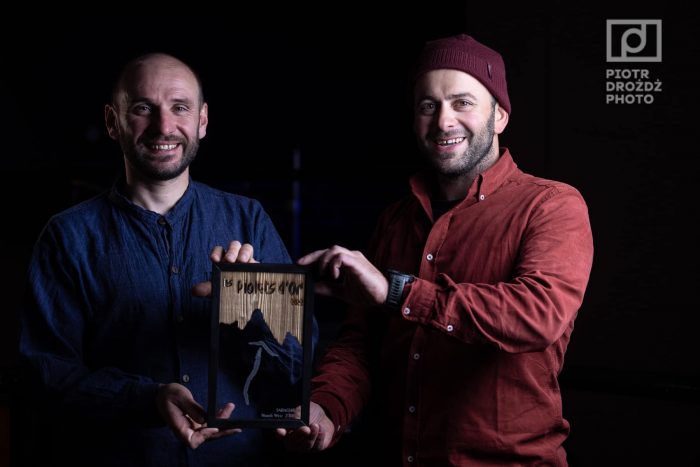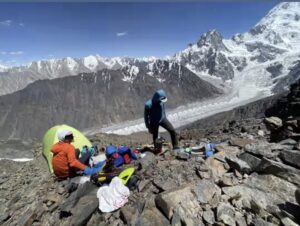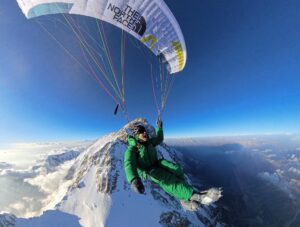But is there a reason why Pakistan attracts more technical teams than Nepal’s Himalaya? The short answer might be that climbing in Pakistan is cheaper. But we wondered if there is something more to it, so we asked some of the climbers in Pakistan this summer.
Climbers on the spot
Matteo della Bordella is currently approaching Baintha Brakk I (also known as The Ogre). He chose it not because it’s in Pakistan rather than Nepal, but because he’s been “fascinated by the photos and by the history of this mountain for a long time.”
Della Bordella is teaming up with elite climbers Francois Cazzanelli, Symon Welfringer, and Silvan Schupbach to attempt this steep and strikingly beautiful 7,000’er. The Ogre has been climbed only three times before. Della Bordella and his partners know that the odds are against them, despite their experience and training. All della Bordella hopes is that the mountain gives them a chance.

This photo by Kenro Nakajima in the Hindu Kush expresses a whole philosophy of exploration.
Kazuya Hiraide of Japan simply looks for the blank spaces left on a map of the Himalaya. He started by marking all peaks that had been already climbed, then heads for the blank spaces, many of which are in Pakistan. Currently, he is heading to Tirich Mir with his regular partner, Kenro Nakajima.
Archil Badriashvili: more old-fashioned adventure
Archil Badriashvili of Georgia led the team that opened a new route on the isolated Saraghrar in Pakistan’s Hindu Kush last year. They won a Piolet d’Or for their effort.
He might also have awakened the climbing world to this region near the Afghan border that has seen few visitors until now. This year, three teams have chosen to go there. Says Badriashvili:
When looking closely at climbing options in Pakistan and in Nepal, there are many differences: People, mountain features and shapes, weather patterns, accessibility, affordability, etc. Nepal is an old, famous player in mountain tourism. After decades, they have focused on making the adventure safer, easier — more assisted, in one word. Tourism has become the state’s top priority.
Giorgi Tepnadze and Archil Badriashvili at the Piolet d’Or Ceremony. Photo: Piolet d’Or
However, this kind of assisted tourism is not for everyone. The exploration of the Karakoram started later and has evolved differently. Today, climbing 8,000’ers in Pakistan and Nepal are similar. But exploratory mountaineering is quite different in the two places.
Perhaps what extreme mountaineers seek in Pakistan is the adventure itself, as well as fewer expenses and more steepness to the peaks. Adventure is intrinsic to the harsh Pakistani mountains: incomparable granite towers, sharp summits of eternal ice, with few climbs on the record. That is a draw all its own!
Holecek: Affordable for young climbers
Marek Holecek of the Czech Republic has one Piolet d’Or after a climb in Nepal (Chamlang) and another in Pakistan (Gasherbrum I). Last year, he attempted a new route on Masherbrum, and this past spring he and Matej Bernat opened a new route on Nepal’s Sura Peak. So Holecek knows about climbing in both countries. Asked why Pakistan seems to attract bold, young climbers, he replied:
The answer is quite simple: Nepal has gradually become a destination where officials have become voracious! The overall price of an expedition makes Nepal an unaffordable destination for many young climbers. Just to give you an idea, the base price for Sura Peak was $8,000. The total cost for porters, porter insurance, personal insurance, plane tickets to Nepal and Lukla, as well as life on site was $15,000 for two climbers. I’m not counting climbing gear.
So it’s no wonder that young climbers who don’t have a VISA Gold card or a rich aunt in America are looking for alternatives. I’m not talking about commercial expeditions, where mountain tourism is booming.
Marek Holecek, right, and Matej Bernat on the summit of Nepal’s Sura Peak this past spring. Photo: Marek Holecek
Pakistan is definitely cheaper, except for the area around the Baltoro and Abruzzi Glaciers, where the price for a permit and the mandatory service also touch the stars.
Holecek also pointed out that the Indian and Chinese Himalaya are also affordable alternatives to Nepal. So are the Afghan Hindu Kush and Kyrgyzstan and Tajikistan’s Pamir-Alay.
Urubko: Friendly to mountaineers

Denis Urubko sets up camp for the night on Koshar Gang, near Skardu, some days ago. Photo: Maria Cardell







